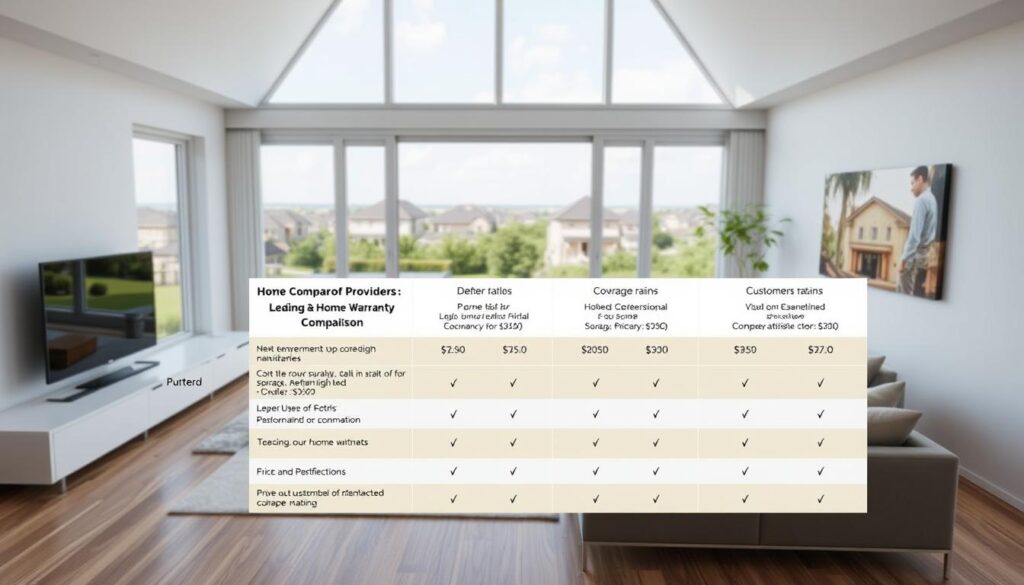More homeowners are considering protection plans for their appliances and systems. Searches for these services have grown steadily over the past six years, showing rising interest. In 2020 alone, 1.4 million U.S. homes were sold with warranties included, according to industry reports.
A good coverage plan can save you from unexpected repair bills. Whether your HVAC system fails or your refrigerator stops working, the right warranty helps avoid costly surprises. This guide will walk you through key factors to consider.
Think about the age of your appliances, available coverage options, and provider reputation. Making an informed decision ensures peace of mind and financial security.
Key Takeaways
- Consumer interest in home protection plans has increased significantly.
- Over a million homes included warranties in recent sales.
- Proper coverage prevents expensive emergency repairs.
- Appliance age and provider comparisons matter.
- Personalized plans offer the best value.
Why a Home Warranty Plan Is Worth Considering
Unexpected appliance failures can drain your wallet—unless you have the right protection. In 2022, homeowners spent $567 billion on repairs, a 17% jump from the previous year. A home warranty acts as a safety net, covering everything from fridge breakdowns to AC meltdowns.
Peace of mind against unexpected breakdowns
Imagine canceling a vacation because your AC died in July. Without coverage, you’d face a $4,000–$12,000 replacement bill. Providers like Liberty Home Guard offer 24/7 emergency service, so you’re never stranded. Cinch even backs repairs for 180 days—no second guesses.
Reducing repair and maintenance costs
Homeowners insurance won’t cover wear and tear. But with a warranty, a $75–$125 service fee replaces a $1,500 repair. That’s the difference between a minor inconvenience and a budget crisis.
“The average HVAC system lasts 10–15 years—but failures often happen sooner in extreme climates.”
Bottom line? A warranty turns unpredictable costs into predictable expenses. Whether it’s your dishwasher or electrical system, you’ll sleep easier knowing you’re covered.
How to Choose the Right Home Warranty Plan for Your Needs
Protecting your major appliances shouldn’t feel like a gamble. The right warranty plan matches your home’s specific needs, from aging HVAC units to smart refrigerators. Start by evaluating three critical factors.
Assess appliance age and condition
Older items break down more often. Data from Cinch shows appliances over 5 years old have a 67% higher failure risk. Create a quick checklist:
- HVAC systems (average lifespan: 10–15 years)
- Water heaters (8–12 years)
- Kitchen appliances (refrigerators: 10–15 years)
Providers like American Home Protect offer extended 3-year plans for aging home systems appliances, while most cover just one year.
Dig into your home inspection report
Hidden flaws in electrical wiring or plumbing often surface later. Your inspection report reveals vulnerabilities a covered home warranty could address. For example:
- Corroded pipes
- Outdated circuit breakers
- Inefficient HVAC ductwork
Document pre-existing conditions
Undisclosed issues lead to denied claims. Liberty Home Guard’s smart home integration helps track system health, but you should also:
- Save repair receipts
- Note appliance purchase dates
- Compare maintenance costs in a spreadsheet
“A 2023 industry study found 22% of warranty claims are rejected due to undocumented pre-existing conditions.”
Proactive planning ensures your coverage options work when you need them most.
Key Factors to Compare Home Warranty Providers
Not all home warranty companies offer the same level of protection. To find the best fit, focus on coverage details, service quality, and real customer feedback. Here’s what to scrutinize.

Coverage options and exclusions
Limits matter. Some providers cap payouts at $1,500 per item, while others offer $3,000. Cinch stands out with appliance component coverage and a $25 AC filter credit. American Home Protect bundles handyman services—a rare perk.
Watch for exclusions like:
- Pre-existing conditions
- Cosmetic damages
- Commercial-grade appliances
Service fees and response times
Fees range from $75–$125 per visit. Faster response times (24–48 hours) save you from sweltering summers without AC. Check if providers use local technicians or national chains—local often means quicker fixes.
Customer reviews and industry ratings
Dig beyond star ratings. Analyze patterns in Trustpilot or BBB complaints. Cinch’s digital dashboard streamlines claims, while others rely on phone calls. Look for:
- Workmanship guarantees (e.g., 180-day repair warranties)
- Transparency in claim denials
- Responsive customer support
“Top-rated providers resolve 89% of claims within 48 hours, per ConsumerAffairs’ 2023 analysis.”
Comparing these factors ensures you partner with a provider that delivers when you need it most.
Understanding Home Warranty Costs and Budgeting
Smart financial planning includes preparing for unexpected home repairs. Warranty costs vary widely, but knowing how to budget for them ensures you’re never caught off guard. Industry data shows plans typically range from $423–$892 annually, with payment options like Cinch’s monthly installments or annual discounts.
Breaking down the price components
Your total cost combines three factors:
- Base premium: Covers core systems (HVAC, plumbing)
- Add-ons: Pool equipment or second fridge coverage
- Service fees: $75–$125 per repair visit
Location matters too. Floridians pay 22% more for AC coverage than Minnesotans due to year-round use. Always compare regional pricing.
When warranties save you money
A single HVAC replacement ($4,000+) could equal three years of premiums. Rental property owners get extra perks—warranty costs are often tax-deductible as maintenance expenses.
“Homeowners with warranties save an average of $1,200 annually on repairs, according to 2023 claims data.”
Weigh warranty plan costs against your emergency fund. If saving $5,000 for repairs seems daunting, a $500 annual premium might be smarter. The right budget balance keeps your home—and wallet—secure.
When Is the Best Time to Buy a Home Warranty?
Timing matters when securing coverage for your appliances and systems. Whether you’re moving into a right home or protecting an existing one, strategic enrollment saves money and stress.
Seasonal trends vs. immediate needs
Demand spikes in summer for AC units and winter for heaters. Cinch reports 68% of home warranties are purchased in spring/summer. But don’t wait for a breakdown—older appliances need proactive coverage.
Consider these seasonal factors:
- Summer: HVAC rush means faster claims but higher service fees.
- Winter: Heating system failures often exceed policy limits.
- Year-round: American Home Protect waives 30-day waits for urgent repairs.
New home purchases vs. existing homes
Builder warranties often expire within a year. Aftermarket warranty plans fill gaps, especially for pre-owned homes. Key differences:
- New constructions: Manufacturer warranties cover defects, not wear and tear.
- Existing homes: Transferring a home warranty during sale simplifies the process for buyers.
“2025 closing cost negotiations increasingly include warranty transfers as a seller concession.”
Match your timing to your home’s life stage. A well-timed policy turns seasonal risks into manageable costs.
Common Mistakes to Avoid When Buying a Home Warranty
Many homeowners rush into purchasing protection plans without understanding key pitfalls. Skipping research or ignoring fine print often leads to denied claims and unexpected costs. ConsumerAffairs reports 42% of rejections stem from pre-existing conditions—a mistake easily avoided.

Waiting until appliances break down
A Florida family learned this the hard way. Their fridge died two weeks after buying a policy, but the claim was denied due to a 30-day waiting period. Always enroll before emergencies strike—older appliances especially need proactive coverage.
Overlooking service fees and deductibles
That $75 service fee might seem reasonable until you need three repairs in a month. Some companies charge up to $150 for after-hours calls. Budget for:
- Emergency service upcharges (up to 50% more)
- Annual deductible caps
- Separate fees for diagnostics
Choosing inadequate coverage
Basic plans often exclude garage door openers or roof leaks. Compare these services side-by-side:
- Standard: Covers 8 major systems
- Premium: Adds pool equipment, second fridges
“Roof leak claims get denied 3x more often than pipe bursts due to ‘gradual damage’ clauses.”
Use this checklist when reviewing contracts:
- Look for “exclusion” sections in bold
- Verify repair versus replacement terms
- Check if local technicians are available
Smart shoppers find home warranty policies that match their actual needs—not just the cheapest option. These things separate frustrating experiences from true peace of mind.
How to Make the Most of Your Home Warranty Plan
Your coverage works best when you know how to use it. From fast claims to renewal hacks, these strategies ensure your provider delivers value.
Filing Claims Like a Pro
Speed matters when appliances fail. Cinch’s 24/7 online portal skips phone queues, while Liberty Home Guard’s app tracks repairs in real time. Follow these steps:
- Document everything: Snap photos, note model numbers, and describe the failure.
- Compare service options—some providers dispatch technicians faster.
- Request preferred local contractors for repeat visits.
| Provider | Claim Method | Avg. Response Time |
|---|---|---|
| Cinch | Online 24/7 | 18–24 hours |
| Liberty Home Guard | App-based | 12–36 hours |
Renewal Terms Decoded
Most states require 60-day renewal notices. Use this window to:
- Negotiate loyalty discounts (up to 15% off).
- Adjust policy terms if appliance ages or needs change.
- Dispute rate hikes with competitor quotes.
“Preventive maintenance logs boost renewal leverage—providers reward well-maintained systems.”
Remember: Your warranty is a tool. Master the process, and it’ll protect your budget year-round.
The Cinch Home Services Advantage: A Case Study
Cinch Home Services redefines appliance protection with unique perks. Unlike standard home warranty providers, they cover often-overlooked components like refrigerator door seals and oven knobs—details that matter when systems age.
Beyond basic coverage
Their $25 annual HVAC filter credit encourages preventive maintenance. Compare this to competitors:
- Component protection: Covers 23 appliance parts others exclude
- Flexible claims: File via app with photo documentation
- Premium add-ons: Roof leak detection and septic tank servicing
When service meets innovation
A Denver family’s kitchen disaster turned into a success story. Their policy replaced a failed dishwasher, fridge, and range—$8,200 worth of appliances—within 72 hours. Cinch’s 180-day repair guarantee meant no repeat service fees.
“Their technician portal showed real-time repair status updates—no more guessing games.”
Cancellations are straightforward too. Prorated refunds apply if you move or sell your home. For quality protection that adapts to modern needs, this provider delivers.
Conclusion
A solid protection plan turns repair chaos into calm. Focus on cost, coverage limits, and provider reputation to find the best fit. Older appliances? Don’t wait—act now.
Compare quotes from top home warranty providers like Cinch or American Home Protect. Seasonal promotions often slash prices by 10–15%.
Your right home deserves safeguards against surprise bills. With the right warranty plan, you’ll trade stress for steady protection.
FAQ
What does a home warranty plan cover?
Most plans protect major systems like HVAC, plumbing, and electrical, plus appliances such as refrigerators and ovens. Coverage varies by provider, so review options carefully.
How much does a home warranty cost annually?
Prices range from 0 to 0 per year, depending on coverage levels, service fees, and home size. Premiums balance affordability with potential repair savings.
Can I get coverage for older appliances?
Yes, but pre-existing conditions may be excluded. Some providers offer add-ons for aging systems—check terms before purchasing.
Are there seasonal discounts on home warranties?
Providers occasionally run promotions, but immediate needs (like buying a home) often outweigh waiting for deals. Compare year-round pricing too.
What’s the difference between a home warranty and homeowners insurance?
Insurance covers damage from disasters like fires or theft, while warranties handle breakdowns from normal wear and tear on systems and appliances.
How quickly can I file a claim after purchasing?
Most plans have a 30-day waiting period before claims are processed. Emergency coverage might start sooner—confirm with your provider.
Do home warranties require maintenance records?
Some providers ask for proof of routine upkeep to approve claims. Keep receipts for services like HVAC tune-ups to avoid disputes.
Can I transfer my warranty if I sell my home?
Many policies allow transfers to new owners, often for a small fee. This can be a selling point during real estate transactions.


